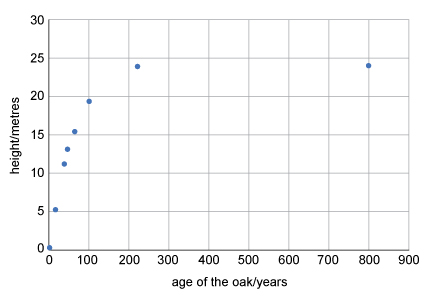2.6 An oak tree
The following slide show describes the life of an oak, using an ancient oak from High Park at Blenheim Palace as a particular example. To better appreciate the age and size of the oak, and the link between them, some calculations are needed.
While working through the slides, record the following information to use in the questions that follow:
- the age and girth of the oldest High Park oak
- the period over which an oak grows fastest
- the approximate age at which an oak becomes mature and produces acorns.
Question 1
Use the conservative age of the ancient oak, estimated in 2017, to calculate the year in which it would it have germinated if it was exactly this age.
Question 2
Using some of the other information that you recorded, in which year did the High Park oak’s ‘growth spurt’ end if it was exactly it’s conservatively estimated age?
Question 3
The time axis in the size–time explorer is in seconds, and the size axis is in metres. Nevertheless, you can use many other units for time (minutes, days, weeks, millennia) depending on the context, so you need to be able to convert between them.
In this question, you will calculate, step by step, the age in seconds of the ancient High Park oak – assuming it is exactly 800 years old. Use the interactive Figure 5 to help you work through the calculations from converting years to days (assuming 1 year = 365.25 days to include leap years), then to hours, to minutes and finally to seconds. At this stage don’t worry about significant figures or scientific notation.
Question 4
Give the age of the oak in standard scientific notation to three significant figures.
Discussion
That is a lot of seconds! You can check that the number you calculated fits with where the oak tree is placed on the size–time explorer.
Now let’s look now at how the oak changed in size over that time. The tree heights over time from the slides are plotted in Figure 6. The first seven data points from the left were calculated from an approximately 220 year-old tree felled at Blenheim Palace, and the data point on the extreme right is from a 800 year old oak that is still standing there.
Question 5
Select the terms from the drop-down options below that best describe the graph in Figure 6
Question 6
What is the girth, or distance around the trunk, of the ancient High Park oak?
Summary
Oaks can live for over one thousand years, but ancient oaks are rare. Survival to this age requires successful germination, growth through seedling and sapling stages, withstanding damage from herbivores and weather and, across the British Isles, being protected from being cut down for timber. Oaks grow very quickly for about 120 years, rapidly increasing in height in this time, in comparison to later years. Many other species depend on oaks, making them a critical part of oak woodland ecosystems.
Next: It is recommended that you keep zooming in, and looking at parts of an organism or living thing – in this case a leaf on the oak, which you can do with the ‘Next >’ button. Alternatively, you can return to the size–time explorer [Tip: hold Ctrl and click a link to open it in a new tab. (Hide tip)] and choose a level yourself.

